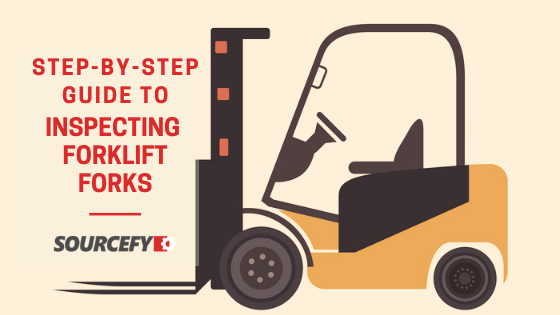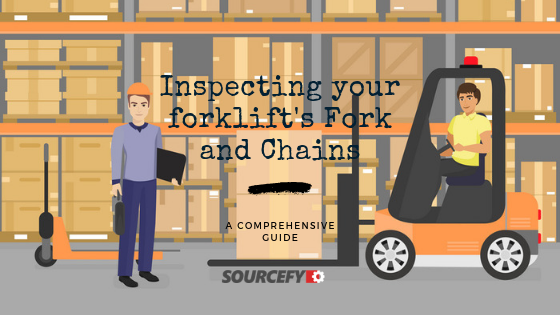Our Products:
Contact Sourcefy:
Address:#108-209 Glen Cove Rd
Carle Place, NY
United States 11514
Email: support@sourcefy.com
Toll-free: 1-855-585-4430
Map
Articles
Step-by-Step Guide To Inspecting Forklift Forks
Posted by on
There’s a lot of things to consider when a stakeholder is trying to inspect a forklift’s forks, especially if they want to keep the forklifts in perfect condition and avoid consistently replacing them. In the case of forklifts, know that no matter how the metal forks on your forklift may seem indestructible, it’s inevitable that they will wear out like any of the other machine parts. Statistics may even show that 29% of all the independently-inspected forks in the forklifts available in the market tend to fail industry tests and safety standards.
In addition, you must understand that just by a simple inspection done to the forks doesn’t constitute the thorough check you are required to do. It’s not even enough to determine that the forks already need replacement. For such reason, the ANSI/ITSDF B-56.1 has made sure that you do what is needed to check that the forks are safe to use.
These industry standards mandated by law would require you to inspect the forks at least once a year if it’s a single-shift operation type of forklift. For powered industrial trucks and forks, the authorities demand that you examine them daily or after each shift, especially if they’re utilized 24/7.
Nothing can put your operators or staff at risk than having your forks unchecked in the right schedule. In fact, missing a fork inspection can lead to a hazardous or even lethal snapped fork or a lowered productivity caused by the dropped load. This suggests that you must also learn the different ways to prevent such an accident from happening, which may also be caused by wrong chain adjustments, running accidents and overloading forks that try to carry beyond capacity.
This is the reason why you have to understand the terminology, definitions, and differentiation involving forklifts and how they relate to helping you increase the lifespan of your machines’ forks. Added here is a list of other tips and modern gadgets that can help you calculate and confirm whether your forklift is working beyond capacity. That said, here’s a comprehensive guide you may want to read and include in your maintenance checklist on how to inspect forklift forks.

Step-by-Step Guide To Inspecting Forklift Forks
1. Checking Blade and Angle - If the shank and blade angle in your forks are already exceeding the 93 degrees threshold, then you should, no questions asked, have that fork replaced. It is immediately important not to operate it nor should you get it to a machine shop to bend the fork back into its proper place.
2. Ensure Straightness - You cannot risk getting your blade and shank to a bent position. If they’re bent, you can guarantee that they’re no longer operational. Replace them as soon as possible.
3. Inspection for Surface Cracks - you shouldn't skip checking for cracks on the surface of the fork. An extra tip for this would have to focus on the heel area and welds because these are the areas where the cracks usually develop.
4. Tip Height Check - The inspection for the fork’s tip height would have to start at the tips of the two forklift blades. They should be made sure that they are roughly at the same height and in proper equilibrium with each other.
You must check if the difference between the height of each tip would exceed three percent of the length of the blade, and if so, you immediately need to get them replaced. Example: when the forklift blade is already about 48-inches long, you can calculate that the difference in height should not exceed 1.44 inches.
5. Positioning Lock Check - You must also make sure that the positioning block and the fork retention devices work properly and they are in perfect balance based on your machine’s operation manual.
6. Calipers Check - You have a lot of tools at your disposal to check if your forks are at their proper state, and one of the simple, reliable ones is the calipers. These calipers measure the thickness of your fork blade, heel and hook using the shaft as the reference point.
These calipers can determine whether the metal on a fork is already worn down and whether the forks can still handle original load capacity. You must remember that a 10% wear can reduce the capacity of the fork by about 20%, which would suggest the forks need a replacement.
7. Check Fork Hooks - An added bonus for using calipers is to check for wear and straightness of fork hooks. When you can observe that the lip of the hook is already touching the back of the caliper, then these forks must be removed from operations.
Added Tips:
When looking for malfunctions in forks, consider checking for the hooks, too. Hooks are vital welds installed on forklifts because they function as the foundation of the lifting and carrying abilities of the forklift. Determine if this hook is about to fail because if it is so, you risk dropping the elevated load, risking the forklift to tip over.
Fork heels have to be inspected, too, checking whether they may be cracks during the lifting of the load or when the forks flex. Metal fatigues and cracks become larger when they don’t get check immediately, and may cause extra damage that can get costly. Remind yourself also that the heel thickness will decrease when the heel is dragged on the floor, especially when the forklift is operated on rough surfaces like blacktop or concrete.
Fork tips are an added accessory or component in forks that play a pivotal role in maintaining your forklift’s optimum shape. Damaged fork tips may not only cause frustration to the operator due to improperly engaged loads, but they can also be costly when not paid any attention. Lastly, it’s ideal to do a daily visual inspection on these areas, using a varying standard of inspection points and standards, depending on the forklift brand or model.

Inspecting your forklift's Fork and Chains
A major topic in any general discussion about forklifts should involve two of its major parts: the forks and chains. For starters, we must begin by saying that forks are the solid hunks of metal installed in the forklift whose sole function would be to lift all pallets and transport their load. It’s another important thing [...]
 Loading... Please wait...
Loading... Please wait...


